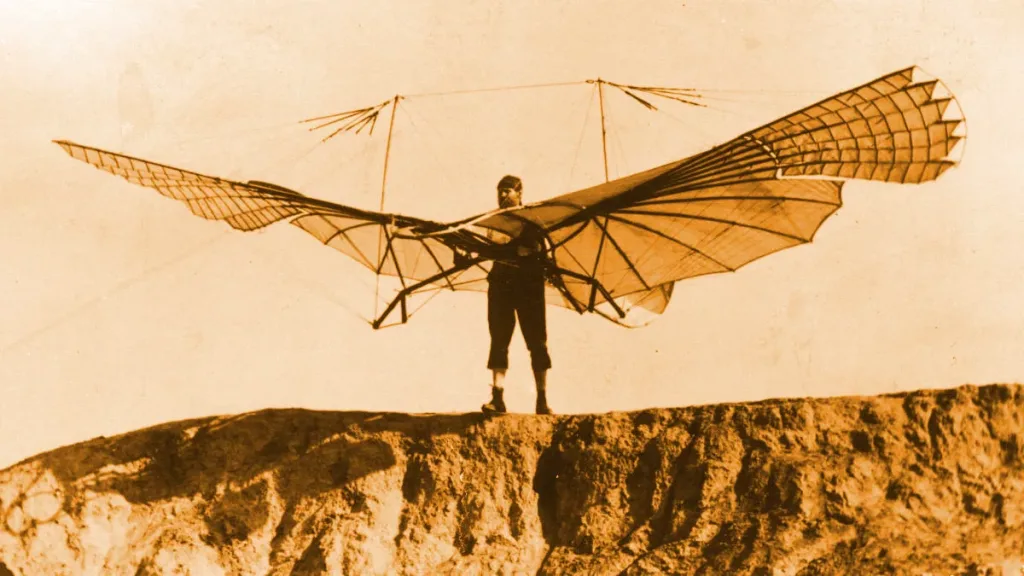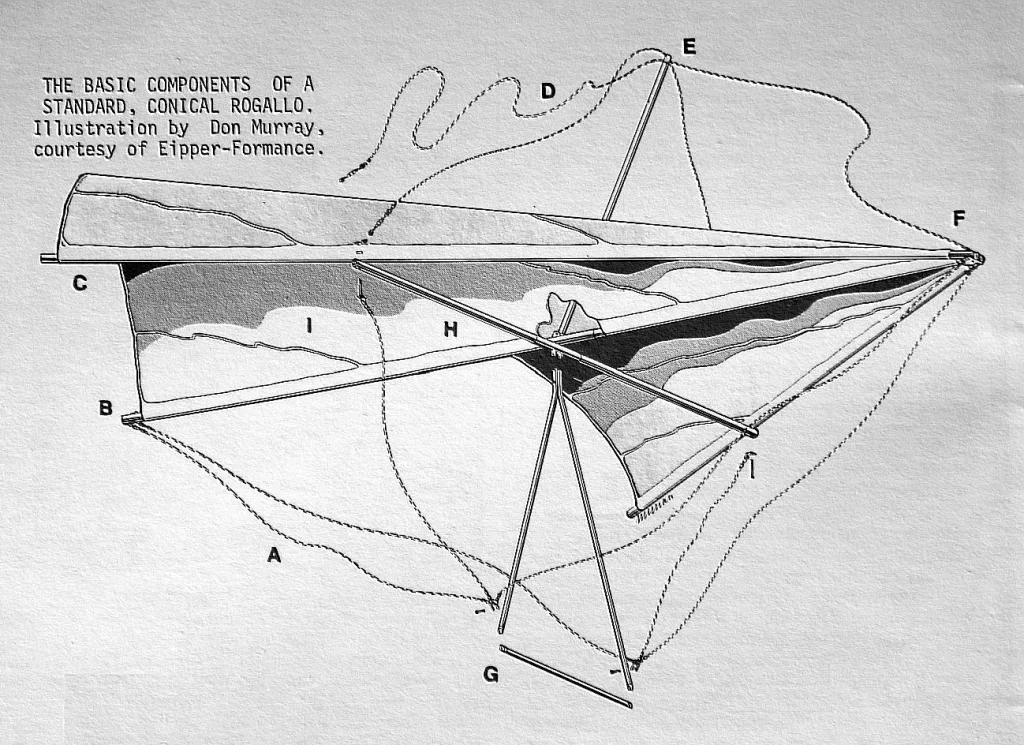
Otto Lilienthal — German aeronautical engineer — 1848–1896
You know what’s really weird?
Most of my working life, I was on a plane flying somewhere. And if I wasn’t, then I was probably on a plane flying back.
So, why on earth would I choose flying as a hobby?
Flying solo — or to give it its proper name, “hang-gliding”.
The start of my hang-gliding “love-affair” was on a Sunday afternoon in 1973. Shirley and I went for a drive from Pershore, Worcestershire (where we were living), into The Black Mountains of Wales. And then, for no particular reason, we visited Hay on Wye.
There, on the mountain-side at Hay Bluff, for the very first time, I saw people defying gravity and flying underneath something called a Rogallo wing.
Talking to those early flyers I learned about a German aeronautical engineer called “Otto Lilienthal” (that’s him up there), who, in the 1890s started it all in Poppenhausen, by demonstrating how we could fly like birds. His weird flying contraption was redesigned in the 1970s into something called a “Rogallo wing”, or “hang-glider” — and my world changed forever!

The first British hang-glider, described as “a Rogallo wing”, was constructed in 1972 by Geoff Mc Broom, in Bristol. I bought a set of plans from Geoff and in 1974, built my first hang-glider in my mother-in-law’s kitchen, then straight away flew it at Malvern, Hay Bluff, Rhossili and Mere.
The sail was Dayglo orange rip-stop nylon. You could see me coming for miles.

The first time I flew my home-built glider was at Malvern, but the flight was not what I expected. I stepped off the top of a relatively small hill and flew directly into the path of a massive thermal which, to my surprise, had just popped off from a tarmacked car park far below. It felt like an invisible elevator which grabbed me and rushed me up to about 1,000 feet above the car park.
This was both my first flight, and my introduction to the power of thermals, all in one day. But, once I got back down on the ground, started breathing again, and enjoying the experience with the small crowd in the car-park, the grin on my face was literally from ear to ear. And I can tell you, that grin lasted all week.

About six months later, I sold my homebrew and bought a professionally made wing. My next glider was a radically different design called a Swift, built for me by Avon Kites in 1976. It was a much higher performance machine, with a wider aspect ratio, which I now flew lying beneath, in a new “supine” harness. I soon found I could soar longer, and fly further, than most other gliders on the hill.
It was an elegant and top-performing kite, of its day, and I took it with me when Shirley, Ruan and I moved to Germany in 1978. I flew that Swift at Minehead, Poppenhausen, Livigno in Italy, Rauschberg, and Füssen.

Take it from me. Looking down the take-off ramp is one thing. Running off the end of it is quite another.
The flights over Neuschwanstein were very dramatic, but the Rauschberg flights were probably the most spectacular, and technically challenging. The Rauschberg is a 1,671-metre high vertical cliff, and the take-off point is over a quarter mile high above the landing area.
The day starts with a long ski-lift ride up the mountain, with your glider stowed on the roof of the cabin. The take-off point is a small metal and wood ramp, pointing at forty-five degrees down to the valley far below.
“Run like hell, and take off in four steps” — they tell you — “if you take more than six, you’ll come off the end!”
It was literally do or die.
What made me take that risk, I imagine you’re asking?
I find that difficult to answer because, to me, it wasn’t a risk. By then I was a fairly accomplished hang-glider pilot, knew my glider was well constructed, safely maintained, and the weather was perfect. Not only that, but I was eager to experience the excitement of flying down the valley and out over Ruhpolding far below.
Was I scared? Yes of course, I was. But if you didn’t have that fear, you wouldn’t be safe, take your time pre-flight checking everything, and carefully preparing for your flight. Inevitably, you’d make a mistake. And you’d die. Or end up with bits missing — bits of you, that is. So, fear was a good thing.
Each time I flew Rauschberg I was scared shitless, but it always worked like clockwork.
1-2-3-4 steps and awaaaaaaaay!

The word “risk” had never been something I had considered. No, that word really didn’t feature in my thinking until we were in Chattanooga, for a late vacation, in 1980. And then, for reasons I’ll explain later, it assumed a much greater significance.
Shirley, and I, plus Eliot (then aged about 9 months), decided to take a few days off, so I loaded the glider onto the roof of our Chevy Blazer, and we drove the 438 miles South from St. Louis, where we were now living.
On the way there, we stopped at some dunes and prepared to test fly the new wing in what looked like what would be forgiving conditions. Crash landing in soft sand has got to be better than hard ground, or rocks, right?
Well, it didn’t go too well. I took off from a dune of about 400 feet and almost immediately flew too slowly and stalled a wing. The effect was that the glider dropped like a stone, veered off to the right, and careened towards the ground.
My first landing (a.k.a anything you can walk away from), with my new glider. I had the wind knocked out of me, but there were no broken bones. And nothing was bent on the glider. I was going to have to remember to fly this one way faster than I’d been used to.
So much for flight testing.
We arrived late evening in Chattanooga and took a room in a cheap motel out in the boonies; one that offered water-beds (yes, you get the picture). Anyway, we were up early the following morning (the beds were freezing), grabbed a quick breakfast at “Jack-in-the-box”, and headed out to “Lookout Mountain”.
When we got to the take-off spot, we could see the wind-sock was blowing in the wrong direction, which meant it would be too risky (there’s that word). Unfortunately, Lookout Mountain is the only game in town, and you might have to drive hundreds of miles to find another mountain, with a take-off spot that’s facing the right direction.
So, that was that then. We went back one last time in the afternoon, but the wind never changed direction. It was still too risky (there’s that word again).
Game over, man!
On the long drive back to St. Louis, with my wife and son asleep beside me, I went over a lot of stuff in my head, and thought deeply about the risks involved in this sport of mine.
Suppose I’d said, “the hell with the risk”, tried that downwind take-off at Lookout, and it hadn’t gone well for me? How might that have played out for them?
Maybe I was still shaken by the poor experience I’d had with the new glider stalling on me the previous day, but I came to the decision not to fly hang-gliders again.
I’d had a few incredible years, going to astonishing places around the world, enjoying wonderful fun and unbelievable camaraderie, doing things most folk would never dream of doing.
It had been an extraordinary period of my life.
But, I was a father now, and I needed to take life and my responsibilities a little more seriously. Besides, I wanted to be there when the wee man grew up, and see his life develop. And flying hang-gliders definitely risked that happening.
Being there, seeing Eliot grow up and providing for my family were far more important to me than any hobby or pastime.
In the end, the decision was easy. I sold the glider the following month, never flew solo again, and that was the end of my hang-gliding love affair.
”I’ve had a wonderful life, so far. I’d like it to continue.”
~ Terence Milbourn
Leave a Reply